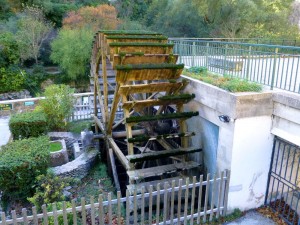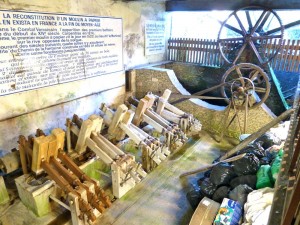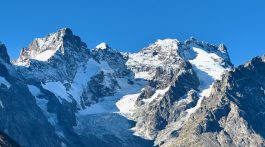A twisting road leads you down into a small market square, flanked on every side with restaurants and you are in Fontaine de Vaucluse. With the high surrounding ‘mountainous’ hills encasing it in, Fontaine de Vaucluse feels as if it has been enfolded into the the end of the narrow valley.
 Here the Sorgue River inexplicably takes its source, from the beautiful and mysterious spring feeding it. This spring, one of the world’s largest, is from deep underground – no one has been able to discover how deep, even Jacques Yves Cousteau in the 1950’s could not find its bottom! Once known as the ‘closed valley’ ~ Vaucluse, it is from this that not only the town derives its name, but also the department of Vaucluse when it was created in 1793.
Here the Sorgue River inexplicably takes its source, from the beautiful and mysterious spring feeding it. This spring, one of the world’s largest, is from deep underground – no one has been able to discover how deep, even Jacques Yves Cousteau in the 1950’s could not find its bottom! Once known as the ‘closed valley’ ~ Vaucluse, it is from this that not only the town derives its name, but also the department of Vaucluse when it was created in 1793.
As you wind your way alongside the stunningly clear, turquoise blue water, on one side are the ruins of a Roman canal. Towering dramatically high above are the ruins of the Bishop of Cavillon’s castle.
The crystal rushing water beside you swirls with fresh green bamboo, washed down from the hills, bouncing its way over the natural weirs and waterfalls. A canoeist’s haven and there were several of them out, negotiating the bubbling froth which rapidly becomes the sparkling, vivid emerald Sorgue river dominating Fontaine de Vaucluse. One cannot help but wonder whether the cave like features in the hills above once provided  shelter for the very earliest settler. It would hardly seem out of context or even surprising to see a man clad in animal skins suddenly appear holding a long, hand carved spear. The entire setting lends itself to such imaginings and drama!
shelter for the very earliest settler. It would hardly seem out of context or even surprising to see a man clad in animal skins suddenly appear holding a long, hand carved spear. The entire setting lends itself to such imaginings and drama!
We were fascinated to watch the worn, seemingly timeless water mill, wrapped in a mantel of sodden moss as it spluttered and halted and then suddenly sprung to life again. We soon discovered that this mill was a critical component to a 15th century paper mill, Vallis Clausa, where they ar e still making paper in the traditional method today.
e still making paper in the traditional method today.
It is possible to watch this original, early paper making process and learn the incredible, time intensive craftsmanship that was required to manufacture the first paper. It is not surprising that paper was originally such an e xpensive and much prized commodity. A far cry from purchasing a bundle of 500 sheets today for virtually nothing!
xpensive and much prized commodity. A far cry from purchasing a bundle of 500 sheets today for virtually nothing!
Download The Lourmarin Travel Guide to learn more about this beautiful region, do let me know your recommendations !




